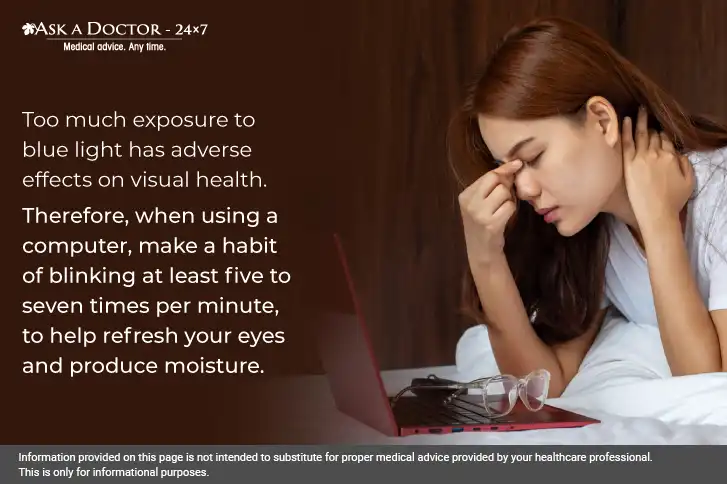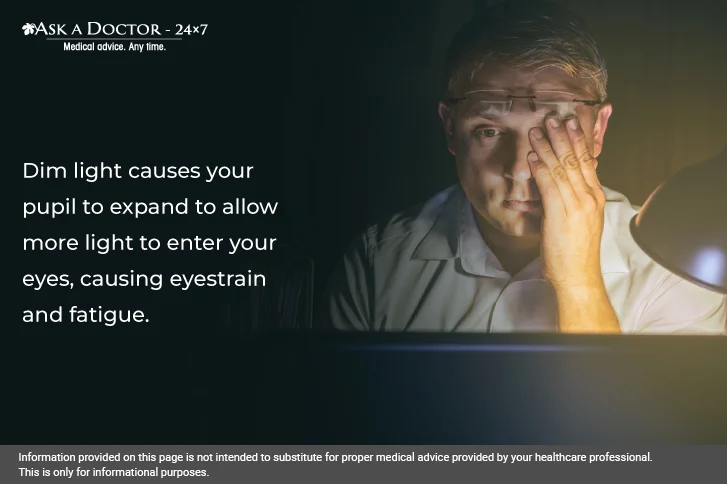7 Useful Eye Care Tips When Working From Home
The eyes are precious sense organs. the windows of sight work tirelessly from the moment we get up until we sleep at night. Since the pandemic, people have shifted to working from home and peering at the screen all the time for prolonged virtual meetings, work, in-depth web research, or just scrolling. Constantly gluing to digital devices has put our eyes at high risk of digital eye strain or computer vision syndrome. By the end of the day dry eyes, eye strain, headaches, hazy vision, or visual fatigue are common woes experienced by people working from home.
Therefore, here in this blog, we have penned down a few eyecare tips to help ease the eyes and protect the vision of those working from home. Read on...
7 Eye Care Tips to Protect Vision While Working From Home

We all know and must have read that excessive screen time can damage our eye health. As most professionals can't reduce screen time due to work commitments, let's learn a few ways to combat common eye issues.
Below are seven useful tips to keep your eyes healthy and protect your vision while working from home:
1. Light up
Change your lighting, a setting that’s too bright or dim strains your eyes and causes discomfort. Working in dim light will tire your eyes out more quickly. Make sure the room is well-lit. Your screen should be bright enough that you don’t squint. Avoid using a mobile or laptop in the dark with the screen as the glowing light source. Adjust the brightness of your screen to match the lighting in your room. Position the screen of your laptop or mobile at your eye level. To reduce glare, apply an anti-glare filter or matte screen or wear an antireflective pair of blue-light-blocking glasses. You can also adjust your computer to night light mode.
2. Follow the 20-20-20 rule
The 20-20-20 rule is simple, focusing on frequent breaks to reduce eye discomfort and strain. Take a break from the screen every 20 minutes for 20 seconds. Focus your attention on something 20 feet away. The rule is effective in decreasing strain on eye muscles. The rule helps in enhancing focus and productivity at work. Implement the rule by setting up a timer to take a break every 20 minutes and look at the object 20 feet away to relax your muscles. Taking screen breaks will help in improving overall eye health.
3. Blink more
Regular blinking is pivotal in decreasing dryness and enhancing your eye comfort level. Blinking helps remove any dust or debris in the eyes, produces moisture, and more tear formation. Blinking is an involuntary movement that protects your eyes. Take regular breaks between your screen time, close your eyes, and blink hard at least three times. This helps in relaxing your eye muscles. Blinking moisturizes the eyes and helps eyes from drying out.
4. Maintain a safe distance between your eyes and devices
Many people have a bad habit of holding their digital devices laptops or mobiles close to their eyes. Such people are more prone to develop long-term vision problems especially when working for a long time. You must keep your devices at a distance of about 50-100 cm from your eyes. Maintaining good distance is critical for avoiding eye strain discomfort, and potential long-term eye health issues. Sit properly and align the top of the screen at the eyebrow level. Your screen should be at a 15-to-20-degree angle downward along your line of vision. Also. increase the font size and avoid leaning closer to the screen to read.
5. Do eye exercises
Your eyes need exercise just like the rest of your body. Exercises such as rolling your eyes or rotational viewing help in releasing tension and soreness in eye muscles. Also, moving your eyes vertically and horizontally helps in stretching tired muscles. Warm compressing the muscles after a long day helps relieve eye strain and trigger tears. Palming your eyes helps in recover from hard work more easily. Palm your eyes for at least thirty to sixty seconds, and repeat whenever your eyes feel tired. Try to do all these exercises at least three to five times in a row every hour to help relieve eye strain.
6. Avoid skipping your glasses
Wear your prescription glasses, skipping them while working is the worst thing you could do to your eyes. Simply putting on prescription glasses helps you see clearly and reduce the strain on your eyes. Failing to do so can further deteriorate your vision, especially when glued to your screen for a long time. Prescription glasses correct any vision problems and increase your comfort level.
7. Get an eye exam done regularly
No matter how many hours a day you spend online, regularly scheduling your eye exams is vital for your eye health. A comprehensive exam can detect issues early and help prevent computer vision syndrome and related complications. If you're noticing any change in your eyes or vision do not ignore it, see your eye doctor immediately and get it checked.
Conclusion

The key to working from home for a long time is maintaining balance and following digital hygiene. Make sure to take frequent breaks and set up your workstation appropriately. Adjust screen settings such as brightness, contrast, and font size according to your comfort level before starting your day. Keep your screen clean from dust, dirt, smudges, fingerprints, or stains to avoid discomfort.
If you are experiencing eye discomfort, consult your doctor or ask an online specialist without delay. You can also ask an ophthalmologist online to learn more about computer vision syndrome or dry eyes.
Recently Answered Queries Related to Eyecare
- Is It Safe To Use Hydrogen Peroxide (3%) In Eye Care Solution To Treat Stye?
- Have Myopia. Prescribed Different Powers At Different Eye Care Center And Able To Read Correctly?
- What Should I Do For Better Eye Care Daily?
- What Precautions Should Be Taken For The Myopia In A Diabetic?
- Suggest Treatment For Acne On Eyelid Margin
Disclaimer: Information provided on this page is not intended to substitute for proper medical advice provided by your healthcare professional. This is only for informational purposes.
Ask a Specialist
Recent Questions


